General Ordinances - City of New Buffalo
General Ordinances - City of New Buffalo
General Ordinances - City of New Buffalo
You also want an ePaper? Increase the reach of your titles
YUMPU automatically turns print PDFs into web optimized ePapers that Google loves.
CITY OF NEW BUFFALO<br />
CODE OF ORDINANCES<br />
ARTICLE II. RULES AND REGULATIONS.<br />
Section 16-9. Use <strong>of</strong> public sewers required.<br />
A. It shall be unlawful for any person to place, deposit, or permit to be deposited in any unsanitary manner upon<br />
public or private property within the <strong>City</strong> or in any area under the jurisdiction <strong>of</strong> said <strong>City</strong>, any human or animal<br />
excrement, garbage, or other objectionable waste.<br />
B. It shall be unlawful to discharge to any natural outlet or drain within the <strong>City</strong> or in any area under the<br />
jurisdiction <strong>of</strong> said <strong>City</strong> any sewage or other polluted waters, except where suitable treatment has been provided<br />
in accordance with subsequent provisions <strong>of</strong> this ordinance or the requirements <strong>of</strong> law.<br />
C. Except as hereinafter provided, it shall be unlawful to construct or maintain any privy, privy vault, septic tank,<br />
cesspool, or other facility intended or used for the disposal <strong>of</strong> sewage in the <strong>City</strong>.<br />
D. Structures in which sewage originates shall be connected to any available sanitary sewer in accordance with the<br />
provisions <strong>of</strong> Section 16-6.<br />
E. Any industry or structure discharging process flow to the sanitary sewer, storm sewer, or receiving stream shall<br />
file the material listed below with the Joint Board <strong>of</strong> the District. The District may require each person who<br />
applies for or receives sewer service, or through the nature <strong>of</strong> the enterprise creates a potential environmental<br />
problem, to file the material listed below:<br />
1. File a written statement setting forth the nature <strong>of</strong> the enterprise, the source and amount <strong>of</strong> water used, the<br />
amount <strong>of</strong> water to be discharged, with its present or expected bacterial, physical, chemical, radioactive, or<br />
other pertinent characteristics <strong>of</strong> the wastes.<br />
2. Provide a plan map <strong>of</strong> the building, works, or complex with each outfall to the surface waters, sanitary<br />
sewer, storm sewer, natural watercourse, or ground waters noted, described and the waste stream identified.<br />
3. Sample test and file reports with the District and the appropriate state agencies on appropriate<br />
characteristics <strong>of</strong> wastes on a schedule, at locations and according to methods approved by the Joint Board.<br />
4. Place waste treatment facilities, process facilities waste streams, or other potential waste problems under<br />
the specific supervision and control <strong>of</strong> persons who have been certified by an appropriate state agency as<br />
properly qualified to supervise such facilities.<br />
5. Provide a report on raw materials entering the process or support systems, intermediate materials, final<br />
products, and waste by-products as those factors may affect waste control.<br />
6. Maintain records and file reports on the final disposal <strong>of</strong> specific liquid, solid, sludges, oils, radioactive<br />
materials, solvents or other wastes.<br />
7. If any industrial process is to be altered so as to include or negate a process waste or potential waste written<br />
notification shall be given to the District and be subject to approval.<br />
Chapter 16- SEWERS AND SEWAGE DISPOSAL 16-6



